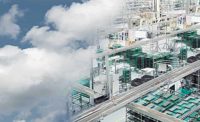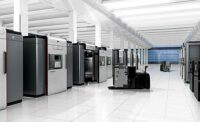
Manufacturers of everything from snack foods to automobiles are being driven to offer higher levels of variety to their customers. Given the proliferation of information now available to shoppers through various digital devices, supply chain power has invariably shifted to the consumer. To retain market share, manufacturers must keep pace with rapidly changing consumer sentiment.
If we were to define the optimal supply chain to meet this trend, it would be one where any item, regardless of complexity, could be produced on demand. Even low-cost commodity products, such as candy, could be produced in a batch size of one. Theoretically, a consumer could select a picture of the family dog from his iPad, upload it to a candy manufacturer’s Web site, and a few days later receive a box of chocolates each in the shape of Scruffy.
If manufacturers are to meet this demand, they’ll have to adopt innovations from the world of gaming and information technology. In short, they must go to “The Cloud”-cloud manufacturing, that is. Cloud manufacturing represents the convergence of information, learned processes, and intelligent motion or activity. For the first time, manufacturers will be able to fully realize the capabilities of robotics, servomotors and other flexible technologies.
For some time now, machinery for assembling, decorating, labeling and packaging has had the ability to change on the fly. The pacing variable has always been process control and ultimately, the information from the consumer. Now, thanks to the unprecedented speed of digital connections between people and the commercial world, this valuable information is available to manufacturers through the cloud.
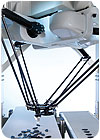
The networking of sensory input, databases and computing resources enables manufacturing systems to recognize complex patterns and execute algorithms to adapt to changing conditions.
The Icing on the Cake
Cloud manufacturing is a model for enabling convenient, on-demand network access to a shared pool of configurable manufacturing resources, such as robotics, control systems, networks, applications and services. The networking of sensory input, databases and computing resources enables manufacturing systems to recognize complex patterns and execute algorithms to adapt to changing conditions. At the same time, reconciliation of environmental conditions and information available in the cloud permits mechatronics to serve as the conduit between the digital and physical world.To illustrate the concept, consider a robot tasked with dispensing icing on a cake. Today a robot is programmed to apply certain patterns and graphics taught by its user. The robot would be outfitted with the ability to dispense various colors with different nozzles, and the system would produce cakes with various images. In a highly controlled environment, a cell with set programmed paths will produce the images without incident.
However, what happens if the environment or the process changes? Consider the following variables: the viscosity of the icing, the ambient temperature, and the humidity within the facility.
The viscosity of the icing is critical and closely controlled. To ensure consistency, the cake decorator will either make the icing himself or source it from a single supplier.
The temperature within the cake factory will affect multiple process parameters. The temperature affects how quickly the cakes cool under ambient conditions. That, in turn, may affect the dimensions of the cakes when they arrive at the automated decorating station. At the same time, if the icing sits in the delivery system for a long period of time and the facility’s temperature varies daily, the viscosity of the icing will change.
Like temperature, humidity can also influence the cake manufacturing process. A higher level of moisture in the batter will affect how well the cakes rise or their dimensions as they cool.
In some cases, simple localized sensory input can adjust for such environmental changes. If cake height fluctuates due to changes in temperature or humidity, various sensors could tell the robot to offset the dispense height to accommodate the change. This rule-based solution is far from complex.
Similarly, viscosity can be measured with sensors located in the delivery equipment or lines. With the appropriate delivery mechanisms, the manner in which the icing is pumped through the lines and ultimately through each nozzle can be profiled and adjusted for viscosity changes.
Based on this example, it would appear that, with the help of sensors and a rule-based control system, the cake-decorating robot should be able to accommodate any environmental changes it encounters, correct? Not so fast. As humidity changes and temperature goes up or down, the icing exhibits different properties of adhesion and setup. So, while the robot may be dispensing the right volume at the right height, that icing carnation may end up looking more like a dandelion. The system could not account for the interplay between all the variables in the process.
When the number of variables becomes sufficiently large, simple, rule-based control systems can get overwhelmed. To continue with our example, let’s add a 3D vision system to our cake-decorating cell. The system will analyze an image of the cake to determine if certain critical features are within spec. The image will be correlated with environmental data cataloging temperature, humidity, icing viscosity, cake height and any other inputs we care to monitor.
As the vision system compares predicted outcomes to actual outcomes, the control system has the ability to dynamically adjust the process. Over time as patterns develop with the information, the process will evolve to accommodate any combination of environmental conditions. The control system will learn how to modify the path of the robot to reliably draw a carnation under any set of conditions.
Cloud manufacturing enables machine learning by comparing a predicted outcome (such as a “golden part” or information stored in a database) with the actual outcome (sensory data from the environment). In our cake-decorating example, the robotic system is the networking device that provides sensory input and ultimately uses the information processed in the cloud to intelligently process the part. The robot acts as the connection between the digital and physical.
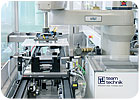
Cloud manufacturing is a model for enabling convenient, on-demand network access to a shared pool of configurable manufacturing resources, such as robotics, control systems, networks, applications and services.
Batch Size of One
Let’s continue with our example of decorating cakes and return to the desire to personalize products for each consumer. Cloud manufacturing provides access to the network where the consumer resides. In a basic model, our baker has a Web site where a customer can upload a photo of his child playing lacrosse so it can be printed on a birthday cake.Ordinarily, this would be a simple printing process for our baker. But our baker wants to reproduce this image with some depth to it, as opposed to a simple, one-dimensional photo.
When the system was set up to make a carnation, the decorator had to program the robot to dispense the icing at a specific rate. The robot also had to place the icing at the correct angle for the appropriate amount of time so that it created one layer of the flower. It would continue to apply layers of icing to the cake’s surface until it produced the complete carnation. It’s unlikely that this was a one-pass programming effort. Indeed, it took time, refinement-and many cakes-to get a carnation that finally met the decorator’s artistic standards.
The challenge with the baker’s business model is that the decorator won’t have the luxury of processing the lacrosse picture numerous times, given the cost of the icing and the limited availability of the robot for practice and programming.
Once again, we find a scenario where the patterns and data set are so large that they overwhelm the capabilities of rule-based programming. With cloud manufacturing, a database will eventually be built over time and through iterations. Using that database, the behavior of the decorating machine will evolve to the point where it knows how much icing has already been deposited, how much is being applied from the nozzle, and adjusts the dispensing process accordingly.
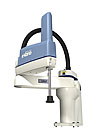
Reconciliation of environmental conditions and information available in the cloud permits mechatronics to serve as the conduit between the digital and physical world.
Reduction in Programming
To realize greater flexibility, manufacturers have come to depend on robotics to deliver incrementally better levels of customization for assembly and packaging. However, one of the greatest barriers to deployment and the largest complaint from users of robots is the programming. Many have asked why they must become proficient in dedicated languages to accomplish moderately straightforward tasks using robots or mechatronics as a whole. The cloud offers solutions to these challenges today and offers even greater promise for the future.Manufacturers have long been familiar with the concept of cloud computing, in which programs are stored remotely and shared across networks. If a cell installed in California is to be replicated in Beijing, a backup program located on a server is simply transferred to the machine, a calibration routine is implemented, and the program is shared. This effectively enables an operator in China to leverage the work done by a programmer in California. As programming languages become increasingly open, algorithms and canned routines will be available in the cloud so that programmers can pull blocks of code as opposed to always starting from scratch.
Machines are just beginning to gain the ability to search for these blocks and, with certain conditions, implement them to affect their activities dynamically. In another example, a recycling plant uses robots to pick glass from a paper line. Today the robot is programmed to identify and remove hundreds of unique types of glass and sort them for optimal recycling. The robot determines all the known products using an onboard processor, which would have been programmed by identifying each product with a local camera. Not only is training the system to recognize hundreds of unique glass types cumbersome and prone to error, it leaves the system unable to adapt to unknown parameters and foreign materials.
However, if the recycling system were to harness computational capabilities and information from the cloud, it might search terabytes of information to identify an object previously unseen at this system’s location. This would function very similar to how “crawlers” search the Web today. In this scenario, once the item is matched to an image in the cloud, a resulting action would be performed as the image is grouped into a product class or family that would instruct the robot how to manipulate and place the item.
This reduces the programming requirements for the system while simultaneously expanding its flexibility almost infinitely. The result is a system that costs significantly less to deploy and provides much greater economic value to the recycler.
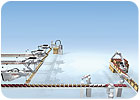
Cloud manufacturing represents the convergence of information, learned processes, and intelligent motion or activity.
Ecosystem Drivers
The concept of cloud manufacturing is not solely driven by the demand for flexibility and efficiency in automated systems. There is a supply-side effect, too. Today’s information technology and networks are enabling faster and less expensive data processing than ever before. Engineers must begin to view factory automation and robotics not as industrial islands, but as devices within an “information ecosystem.”Historically, a manufacturing machine’s only connections to its environment were the power source, the input of raw materials, and the output of processed goods. As such, it could not adapt to any form of change.
The industrial revolution was all about mass production. It made products that were once considered luxuries affordable for everyone. Manufacturers employed processes to produce things faster and more consistently, but flexibility was not essential. Consumers could have any color car they wanted from Ford, as long as it was black.
As manufacturing enters the information revolution, machinery and automation will generate and consume greater amounts of data so they can increase quality through dynamic process control, satisfy consumers’ appetite for mass customization, and decrease implementation costs through learned heuristics. Unlike the productivity gains of the Henry Ford era, today’s gains will be driven by better utilization of information technology.
ASSEMBLY ONLINE
For more information on assembly automation, visit www.assemblymag.com to read these articles:•Assembly In Action: Robot Helps Watch Manufacturer Double Production.
•Robotics: A Sunny Disposition.
•Robot Safety Comes of Age.
